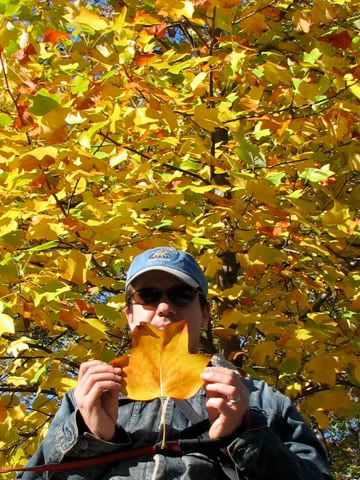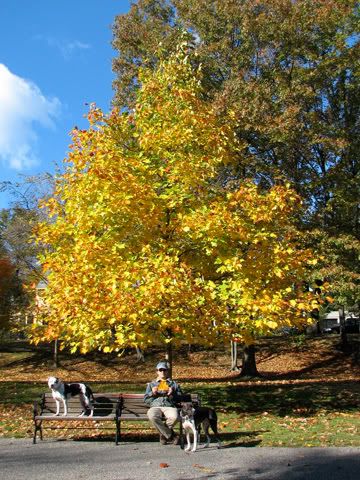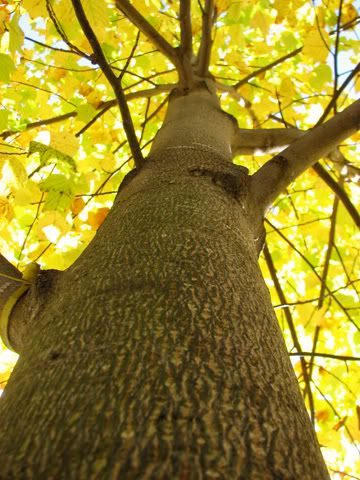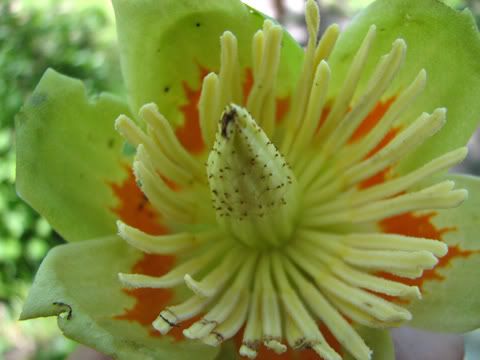365 Urban Species. #301: Tulip Poplar
.
Photos by cottonmanifesto. Location: Olmsted Park.
Urban species #301: Tulip poplar Liriodendron tulipifera
Also called tuliptree and yellow poplar, this tree is thoroughly unrelated to both tulips and poplars. Conflicting yet complimentary explanations exist for the "tulip" part of its name. Its sturdy flowers, held way up in the higher branches, somewhat resemble tulips. Its four-lobed leaf, rather like a maple leaf missing its middle point, looks like the silhouette of a tulip. The tree is, in fact, a member of the magnolia family, occurring relatively farther north than many others. It is native to the eastern part of North America, but its hardiness, beauty, and usefulness as a timber producer, have encouraged plantings in other regions and on other continents. Three states--Indiana, Kentucky, and Tennessee--have named tulip poplar as their state tree.
Tulip poplar is relatively resistant to caterpillar predation and other urban stresses, and a healthy individual could grow to more than 100 feet tall. They are chosen for plantings in open areas in the city, as they do not tolerate deep shade. Their leaves turn golden yellow in Autumn.
Tulip poplars were valued by Native Americans, who used the naturally insect-repellent bark as a purgative, to treat intestinal worms. They also valued the timber for canoe-making. Europeans quickly recognized the tree's value, and it was introduced to Britain in the 1600's. The tulip tree is one of only two members of its genus, the other occurring in China.

A fairly young and small tulip poplar bursts into autumn color.

The tree's bark is distinctive.

A close-up of the flower, taken in spring.

Photos by cottonmanifesto. Location: Olmsted Park.
Urban species #301: Tulip poplar Liriodendron tulipifera
Also called tuliptree and yellow poplar, this tree is thoroughly unrelated to both tulips and poplars. Conflicting yet complimentary explanations exist for the "tulip" part of its name. Its sturdy flowers, held way up in the higher branches, somewhat resemble tulips. Its four-lobed leaf, rather like a maple leaf missing its middle point, looks like the silhouette of a tulip. The tree is, in fact, a member of the magnolia family, occurring relatively farther north than many others. It is native to the eastern part of North America, but its hardiness, beauty, and usefulness as a timber producer, have encouraged plantings in other regions and on other continents. Three states--Indiana, Kentucky, and Tennessee--have named tulip poplar as their state tree.
Tulip poplar is relatively resistant to caterpillar predation and other urban stresses, and a healthy individual could grow to more than 100 feet tall. They are chosen for plantings in open areas in the city, as they do not tolerate deep shade. Their leaves turn golden yellow in Autumn.
Tulip poplars were valued by Native Americans, who used the naturally insect-repellent bark as a purgative, to treat intestinal worms. They also valued the timber for canoe-making. Europeans quickly recognized the tree's value, and it was introduced to Britain in the 1600's. The tulip tree is one of only two members of its genus, the other occurring in China.

A fairly young and small tulip poplar bursts into autumn color.

The tree's bark is distinctive.

A close-up of the flower, taken in spring.